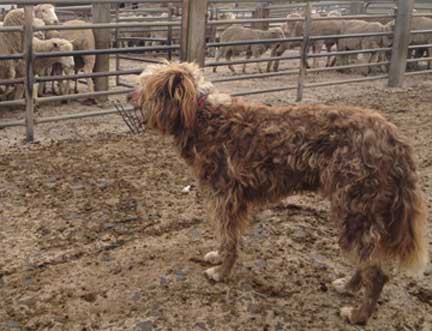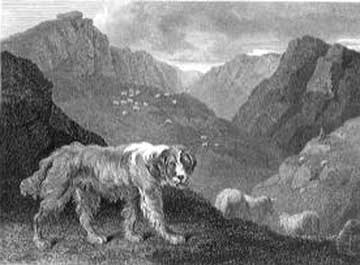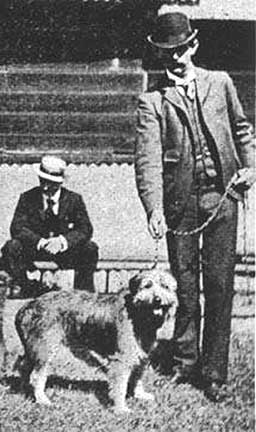

![]()
BORDER COLLIE COUSINS
THE SMITHFIELD

Scruff, a Tasmanian Smithfield belonging to Doug Stevenson
at work at the sale yards in Launceston.
(Photo courtesy of Matthew Larner.)
The Smithfield was originally a drovers dog, more of a type than a breed, called after the Smithfield Market in London where drovers brought their cattle and sheep to be sold. Originally, various types of collies were used by drovers and designated as Smithfields, but eventually a "bearded" type became the norm.
 Left, an old lithograph of a Smithfield in Scotland. (Photo in the public domain.)
Left, an old lithograph of a Smithfield in Scotland. (Photo in the public domain.)
The Smithfield was first brought to Australia during colonial times. Then, most land holdings were small and clustered around Sydney. The Smithfield was used to bring the cattle to market in the same way it had been used in Britain. However, in 1813 immense grazing lands were opened west of Sydney. The outback terrain was difficult, and effectively turned the cattle semi-wild. The Smithfield could not cope and their constant barking put the drovers, their horses, and the cattle on edge. Robert Kaleski said the Smithfield "couldn't stand the heat...bit like an alligator...and barked like a consumptive".[8] This was like a death knell for the type, which may have driven it nearly to extinction on mainland Australia. However it survived in Tasmania, an island off the southeast coast of Victoria, and in southern Australia where, although extremely rare, the type is still used for stockyard and farm work.
In 1973, the Kennel Control Council of Victoria described the Smithfield as "a black bob-tailed dog with a white ring around its neck and extending down its front. It had long hair, big hanging ears, [and] a cumbersome gait...".[22] Robert Kaleski described it as a "big, rough coated, square bodied dog, with a head like a wedge, a white frill round the neck and saddle flap ears. He got over the ground like a native bear."[8] This sounds a like the Old English Sheepdog, but the Tasmanian Smithfield today is more like the old working Bearded Collies or Sussex Sheepdogs, diverse in looks, and similar to the "bearded Borders" that we presented in a previous article.[1] Some have long tails, others natural bobs, and trod lightly on their feet, not like the description above.
 Right, a photo of Jack, a Smithfield at the 1898 Exhibition in Sydney, Australia. (Photo in the public domain.)
Right, a photo of Jack, a Smithfield at the 1898 Exhibition in Sydney, Australia. (Photo in the public domain.)
The Smithfield is a loose-eyed, upright worker that utilizes bark and bite to work stock. They may also growl and gnash their teeth and seem aggressive in style. They are said to be "forceful and fast and game."[23] Owners in Tasmania rallied to form an organization to protect the type as a working dog and today they are recognized by the Tasmanian Working Sheep Dog Association and other agricultural organization in Australia. Like other herding breeds whose jobs are being phased out, they excel in dog sports like agility and flyball. There are Smithfields working stock in Tasmania today where they are at their best working in the stockyards. Their advocates claim that in Tasmania they are purebred while on the mainland many are crossed with Border Collies. At the Campbell Town Show, established in 1838 and characterized as "Tasmania's Premier Sheep Show", there is a yard dog trial for Smithfield dogs for which the only entry conditions are that "all dogs...be bona fide working dogs [and] purity [to be] decided by dog's owner, solely on the basis of the dog's appearance and regardless of known or suspected ancestry."[24]
Resources:
Butler, Roy, District Veterinary Officer, Dryland Research Institute, Department of Agriculture and Food, Western Australia. "The Smithfield Dog in Tasmania", Tasmanian Journal of Agriculture, 1978.
Catalogue for the 167th Annual Exhibition, Campbell Town, Tasmania, Yard Dog Trials (held in 2005).
Dogs of Australia, Kennel Control Council, Victoria, 1973.
Kaleski, Robert. Australian Barkers and Biters, the Endeavor Press, Sydney, 1914, revised edition 1933.
Presberg, Carole L. "The History of the Shepherd's Dog, Part XII: Border Collie Cousins, The Collie Breeds of Britain and Ireland", International Sheepdog News, January/February 2012.
Copyright © 2013 by Carole L. Presberg
Return to
![]()
BORDER COLLIE COUSINS
THE OTHER WEB PAGES WE MAINTAIN
These web pages are copyright ©2013
and maintained by webmeistress Carole Presberg
with technical help from webwizard David Presberg
ALL RIGHTS RESERVED
If you are interested in using ANY material on this website, you MUST first ask for permission.